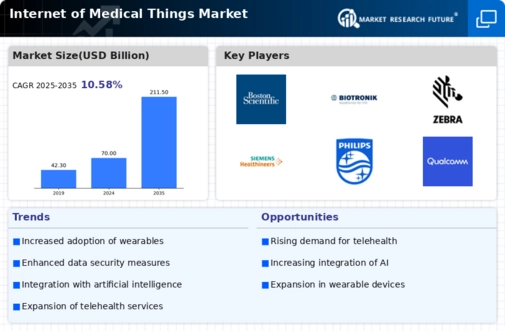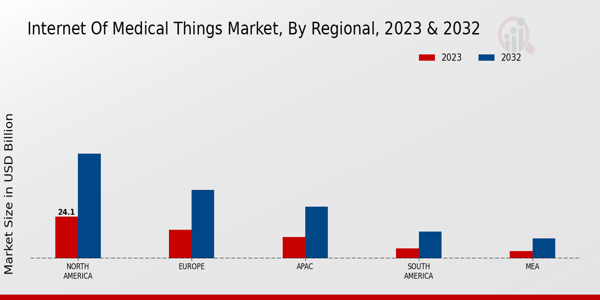Advancements in Wearable Technology
The Internet of Medical Things Market is significantly influenced by advancements in wearable technology. Innovations in sensors and connectivity have led to the development of sophisticated wearable devices that can monitor vital signs, physical activity, and other health metrics. The wearable medical device market is anticipated to grow at a compound annual growth rate of over 20% through 2025. This growth is attributed to the increasing consumer awareness regarding health and fitness, as well as the rising adoption of IoMT solutions in clinical settings. Wearable devices not only empower individuals to take charge of their health but also provide healthcare professionals with valuable data for informed decision-making. As technology continues to evolve, the potential applications of wearables in the Internet of Medical Things Market are likely to expand.
Regulatory Support for IoMT Solutions
The Internet of Medical Things Market is benefiting from increasing regulatory support aimed at promoting the adoption of IoMT solutions. Governments and regulatory bodies are recognizing the potential of IoMT to enhance healthcare delivery and are implementing frameworks to facilitate its integration. For example, initiatives that streamline the approval process for medical devices and promote data interoperability are gaining traction. This regulatory environment encourages innovation and instills confidence among stakeholders, including healthcare providers and technology developers. As regulations evolve to support the safe and effective use of IoMT, the market is likely to experience accelerated growth, paving the way for new applications and services.
Enhanced Patient Engagement and Empowerment
The Internet of Medical Things Market is increasingly focused on enhancing patient engagement and empowerment through technology. IoMT devices enable patients to actively participate in their healthcare journey by providing them with real-time access to their health data. This shift towards patient-centered care is supported by the growing recognition of the importance of patient engagement in improving health outcomes. Studies indicate that engaged patients are more likely to adhere to treatment plans and experience better health results. As healthcare providers leverage IoMT solutions to foster patient engagement, the market is expected to expand, driven by the demand for tools that empower individuals to manage their health proactively.
Growing Investment in Healthcare Technology
The Internet of Medical Things Market is witnessing a surge in investment aimed at enhancing healthcare technology. Venture capital funding for health tech startups has reached unprecedented levels, with billions of dollars being allocated to innovative IoMT solutions. This influx of capital is fostering the development of cutting-edge technologies that improve patient care and operational efficiency. For instance, investments in IoMT platforms that facilitate data sharing and interoperability are becoming increasingly common. As healthcare organizations recognize the value of integrating IoMT into their operations, the market is expected to expand rapidly. This trend indicates a shift towards a more technology-driven healthcare ecosystem, where IoMT plays a pivotal role in delivering quality care.
Rising Demand for Remote Patient Monitoring
The Internet of Medical Things Market is experiencing a notable surge in demand for remote patient monitoring solutions. This trend is largely driven by the increasing prevalence of chronic diseases, which necessitate continuous health monitoring. According to recent estimates, the number of individuals living with chronic conditions is projected to reach 1.5 billion by 2025. Consequently, healthcare providers are increasingly adopting IoMT devices to facilitate real-time monitoring and improve patient outcomes. These devices not only enhance patient engagement but also reduce hospital readmission rates, thereby alleviating the burden on healthcare systems. The integration of IoMT in remote monitoring is expected to transform patient care, making it more proactive and personalized.


















Leave a Comment